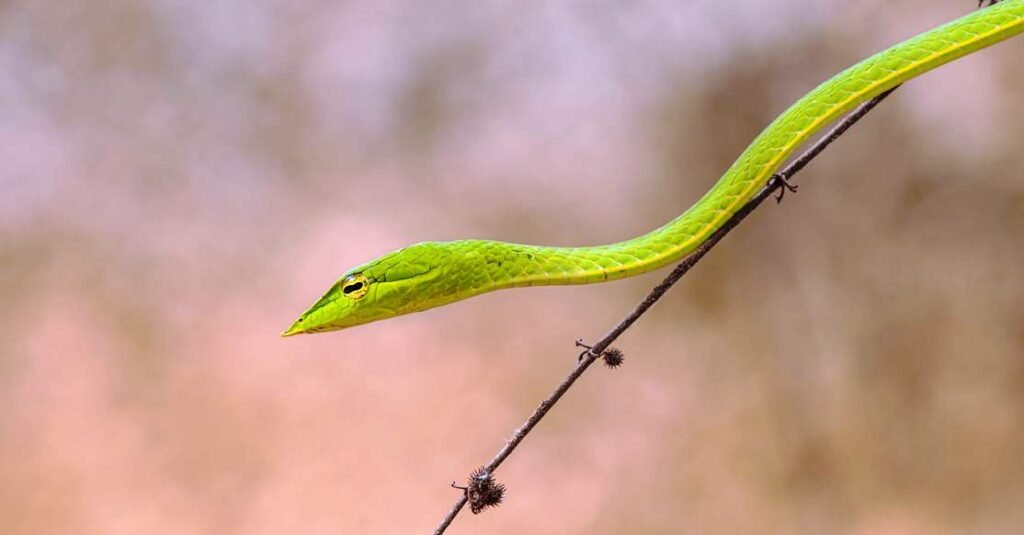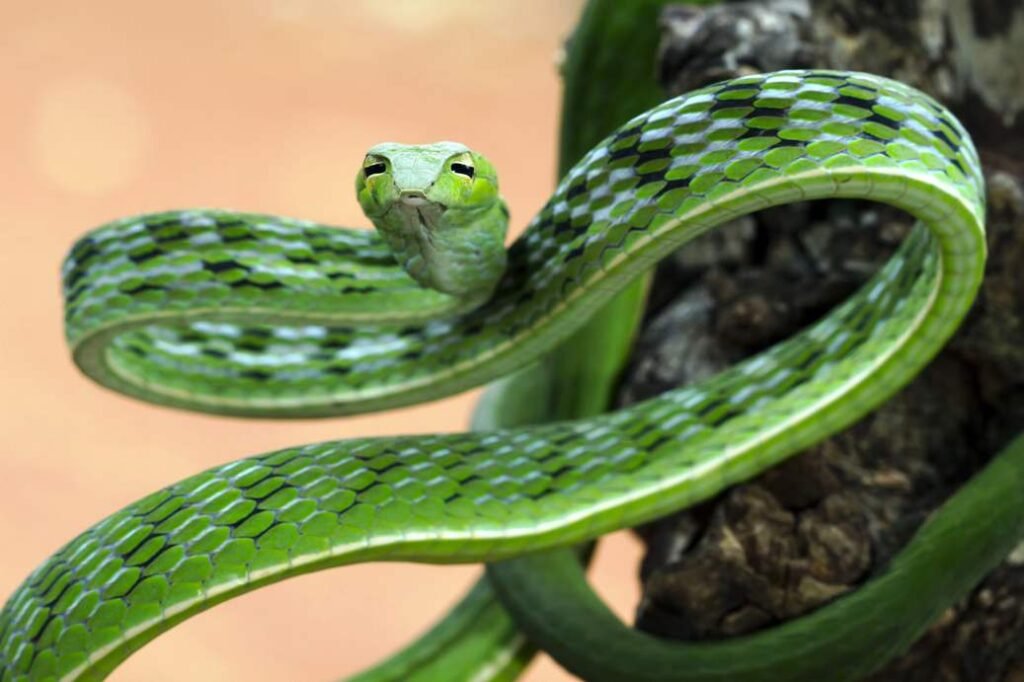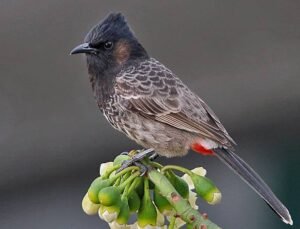Introduction to the Green Vine Snake
The Green Vine Snake is a fascinating and graceful reptile found in various tropical regions. Its slender, elongated body, vibrant green color, and subtle black and white patterns make it a stunning specimen to encounter. This snake’s delicate appearance may be deceptive, as the Green Vine Snake is both an adept hunter and highly adapted to its environment. Known for its unique hunting methods, mild venom, and keen senses, it holds a unique position in the ecosystems it inhabits.

Below, we’ll explore everything about the Green Vine Snake, from its physical characteristics and behavioral traits to its role in the environment, common myths, and misconceptions.
Species Profile: Green Vine Snake
| Attribute | Description |
|---|---|
| Snake Name | Green Vine Snake |
| Scientific Name | Ahaetulla nasuta |
| Wild Life Protection Act (WLPA) Schedule | Schedule IV |
| Regional Names | Hindi: Hara Bel Ka Saap | हरा बेल का सांप Marathi: Harantol | हरणटोळ Tamil: Pachai Paambu | பச்சை பாம்பு Kannada: Hasiru Havu ಹಸಿರು ಹಾವು West Bengal: Laudoga | লাউডগা Malayalam: Pachila Pampu | പച്ചില പാമ്പ് |
| Physical Description | Slender, elongated green body with a pointed head, adapted to camouflage among foliage |
| Habitat | Dense forests, tropical regions, lowland rainforests, and scrublands |
| Diet | Carnivorous; feeds primarily on small lizards, frogs, and insects |
| Behavior | Arboreal, ambush predator, relies on stealth and precision |
| Venomous or Non-Venomous | Venomous (mild venom) |
| Venom Type | Neurotoxic |
| Venom Effects on Prey | Paralyzes smaller prey, making it easier to consume |
| Venom Effects on Humans | Generally harmless; mild symptoms like numbness if bitten |
| Common or Rare Species | Common in native regions |
| Life Span | Around 7–12 years in the wild |
| Mating & Reproduction | Oviparous; lays eggs in secluded areas |
Understanding the Green Vine Snake
General Characteristics and Anatomy
The Green Vine Snake is known for its slender and elongated form, which allows it to blend seamlessly into green foliage. Its unique head shape—pointed and flat—helps it mimic the leaves around it, a powerful form of natural camouflage. The snake’s narrow body and vibrant green color add to its deceptive appearance, often making it look like a twig or vine.
The Role of Green Vine Snakes in the Ecosystem
Green Vine Snakes play an essential role in the ecosystem, helping to control the populations of small reptiles, insects, and amphibians. As a predator, it maintains balance by preying on certain species, which in turn supports biodiversity and ecosystem health. The Green Vine Snake is non-aggressive, generally avoiding human interaction.
Myths and Misconceptions
Many myths surround the Green Vine Snake, including the idea that it is highly venomous and dangerous to humans. In reality, its venom is mild and generally harmless to humans. Other myths portray it as an aggressive hunter, but it actually relies on stealth and camouflage rather than aggression. Educating people on the true nature of this snake can reduce unnecessary fear and promote respect for its ecological role.
Habitat and Distribution
Green Vine Snakes thrive in dense forests, tropical regions, and rainforests. With a preference for humid and lush environments, they often inhabit lowland rainforests and scrublands where dense foliage provides plenty of cover. In addition to tropical forests, they may also be found in wooded gardens and plantations where they can find their prey.
| Habitat Type | Geographical Distribution |
|---|---|
| Dense Forests | India, Sri Lanka, and Southeast Asia |
| Lowland Rainforests | Western Ghats and other tropical regions |
| Scrublands and Wooded Areas | Scattered across tropical Asia |
| Urban Gardens and Plantations | Commonly sighted in rural gardens and plantations |
Green Vine Snakes are distributed across India, Sri Lanka, and Southeast Asia, favoring areas with high humidity and an abundance of small prey. These snakes are arboreal, meaning they spend most of their time in trees, rarely descending to the ground unless necessary. Their ability to blend seamlessly with their environment allows them to thrive in various regions without being easily detected.

Snake Behavior
Hunting and Feeding Habits
Green Vine Snakes are primarily ambush predators. They rely on their camouflage to stay hidden while waiting for unsuspecting prey to come within reach. With exceptional vision and rapid strike speed, these snakes can quickly capture small lizards, frogs, and insects. After catching prey, they inject a mild neurotoxic venom that paralyzes it, making it easier to consume.
Mating and Reproduction
During mating season, Green Vine Snakes engage in unique courtship behaviors. They are oviparous, meaning they lay eggs, typically in secluded or hidden areas. Females may lay around 6–8 eggs at a time, which hatch within a few weeks. The juveniles are entirely independent from birth.
Defense Mechanisms
Green Vine Snakes are non-aggressive and use camouflage as their primary defense. In situations where they feel threatened, they may puff up their bodies and display their black and white lining to appear larger and more intimidating. Their venom, though effective against small prey, poses little threat to humans.
First Aid and Medical Treatment for Green Vine Snake Bites
Green Vine Snake bites are generally harmless to humans, but if a bite does occur, it’s essential to remain calm. Symptoms may include mild numbness or tingling around the bite area. Washing the wound with soap and water is usually sufficient. If any discomfort persists, it is recommended to consult a medical professional for further assistance.
Global Impact of Green Vine Snake Bites
Globally, the Green Vine Snake is not considered a significant threat to humans. Its venom is mild and rarely causes any adverse effects beyond temporary discomfort. However, understanding the snake’s ecology and habits promotes coexistence and reduces unnecessary fear.
If You Encounter a Green Vine Snake on Your Property
- Remain Calm and Assess the Situation: Green Vine Snakes are non-aggressive; avoid sudden movements.
- Ensure Safety: Keep pets and children away from the area.
- Identify the Snake (If Possible): Only attempt identification if you are at a safe distance.
- Contact Professional Help: Reach out to local wildlife control for safe removal.
- Prevent Future Encounters: Trim dense foliage and remove hiding spots to minimize snake activity.
- Educate Yourself and Others: Learn about local snake species to foster awareness and reduce fear.
Tips for Snake Enthusiasts
- How to Safely Observe Snakes in the Wild: Use binoculars and keep a safe distance; avoid touching or disturbing them.
- Tips for Aspiring Herpetologists: Begin with field guides, attend reptile seminars, and consider conservation volunteer programs to gain experience.
Interesting Facts About the Green Vine Snake
- Remarkable Camouflage: The Green Vine Snake can mimic the appearance of vines and branches, making it almost invisible in its natural habitat.
- Unique Head Shape: Its pointed, leaf-like head allows it to blend seamlessly with surrounding leaves.
- Heat-Sensitive Vision: Green Vine Snakes have excellent vision, which helps them spot prey from a distance.
- Warning Display: When threatened, this snake will flare its body to reveal a striking pattern of black and white.
- Mild Venom: Unlike other venomous snakes, the Green Vine Snake’s venom is mild and not dangerous to humans, designed more for paralyzing small prey.
- Quick Reflexes: They strike with remarkable speed and accuracy when capturing prey.
- Independent Juveniles: Hatchlings are fully independent and capable of hunting on their own from birth.
Frequently Asked Questions (FAQ) About the Green Vine Snake
Q1: What is a Green Vine Snake?
A: The Green Vine Snake, scientifically known as Ahaetulla nasuta, is a slender, green-colored snake found in tropical forests, rainforests, and scrublands. Known for its vibrant color and leaf-like appearance, this snake uses camouflage to blend into its surroundings, making it an effective ambush predator.
Q2: Is the Green Vine Snake venomous?
A: Yes, the Green Vine Snake is mildly venomous. Its venom is primarily neurotoxic, effective in paralyzing small prey like lizards and frogs. However, its venom is generally harmless to humans, causing only mild symptoms like numbness or tingling if bitten.
Q3: Where can you find the Green Vine Snake?
A: Green Vine Snakes are native to parts of India, Sri Lanka, and Southeast Asia. They prefer dense forests, tropical rainforests, and areas with abundant foliage where they can easily camouflage among leaves and branches.
Q4: What does the Green Vine Snake eat?
A: The Green Vine Snake primarily feeds on small reptiles such as lizards, frogs, and occasionally insects. It relies on its excellent vision and camouflage to catch prey by surprise, striking quickly with precision.
Q5: How does the Green Vine Snake defend itself?
A: When threatened, the Green Vine Snake puffs up its body to reveal a striking black and white pattern along its sides, which makes it look larger and more intimidating. It also relies heavily on camouflage to remain hidden from potential predators.
Q6: Are Green Vine Snakes dangerous to humans?
A: No, Green Vine Snakes are generally not dangerous to humans. Their venom is mild, and bites are rare and typically harmless. However, it’s always best to avoid handling wild snakes and observe them from a distance.
Q7: What is the lifespan of a Green Vine Snake?
A: In the wild, Green Vine Snakes typically live around 7–12 years. Factors like habitat quality, availability of food, and environmental conditions influence their life expectancy.
Q8: What should I do if I see a Green Vine Snake on my property?
A: Remain calm and keep a safe distance. Green Vine Snakes are non-aggressive and will usually move away if left alone. If needed, contact local wildlife control for safe removal, and consider trimming dense foliage around your property to prevent future encounters.
Q9: Are there any myths about the Green Vine Snake?
A: Yes, one common myth is that the Green Vine Snake is highly venomous and aggressive toward humans. In reality, it has mild venom and prefers to avoid human contact. Another misconception is that it actively chases people, which is entirely untrue; Green Vine Snakes rely on camouflage and avoid threats.
Q10: Can I keep a Green Vine Snake as a pet?
A: While it may be legal in some places, Green Vine Snakes are best left in their natural habitat. They require specific environmental conditions and specialized care. Observing them in the wild or in protected settings is a more ethical and fulfilling experience.
Q11: How do Green Vine Snakes contribute to the ecosystem?
A: Green Vine Snakes help control populations of small reptiles and insects, maintaining balance within their ecosystem. By preying on certain species, they help promote biodiversity and contribute to a healthy environment.
Q12: What are some interesting facts about Green Vine Snakes?
A: Green Vine Snakes have remarkable camouflage, a unique head shape that resembles a leaf, and excellent vision. They also use a “warning display” by puffing up their bodies to appear larger, and they’re one of the few snakes known for their ability to capture prey with swift, accurate strikes.
Related Post
| Article Title | Link |
|---|---|
| What Are Reptiles? | Read More |
| The Big Four Snakes of India | Read More |
| Cobra Snake – All Information | Read More |
| Russell’s Viper | Read More |
| Common Krait – All Information | Read More |
| Saw-Scaled Viper – All Information | Read More |
| King Cobra – All Information | Read More |
| Banded Krait Snake – All Information | Read More |
| Common Cat Snake – All Information | Read More |


